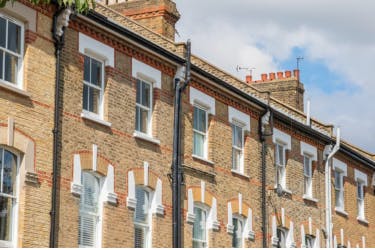What to look for when viewing a house
If you’re a first-time buyer, it can be hard to know what to look for when viewing a house. Here’s an essential house viewing checklist and our top tips.
Buying a house? You deserve a Tembonus
Mortgages can feel like a maze of paperwork and decisions. With HomeSaver, there'll be a reward waiting for you at the finish line, whether you're buying your first place, your next, or remortgaging.
What to look for when buying a house
You’ve found a house on RightMove that you think could be The One. It’s within your budget, you can see yourself living there for years, and you’ve got a viewing booked for this afternoon.
There’s just one problem… you don’t have a clue what to look for when viewing a house and you’re wondering how to make the most of the short time you have.
If you’re unsure what questions to ask or you’re worried about house viewing etiquette, here’s our breakdown of what to look for when viewing a house:
Is the home structurally sound?
Keep an eye out for any big cracks that are wide enough to slide a coin in sideways. Not only are they unsightly and a pain to fill, they could indicate much more serious issues with the house. Hairline cracks are rarely something to worry about, though. Even new builds get them. They can occur when the property ‘settles’ in the years after being built.
If you see a big crack, ask the homeowner or estate agent if they know what caused it. Get in touch with a surveyor once you get home and they’ll take over from there. Although surveys can seem expensive, they can save you thousands further down the line.
Are the rooms big enough?
Small furniture, strategically placed mirrors and carefully curated paint colours are just a few tricks that sellers use to make rooms look bigger than they are.
Don’t forget your tape measure. If you want a king size bed or a huge corner sofa in the centre of the living room, there’s nothing wrong with taking a few measurements — even if the current owners are the ones showing you around.
How old is the roof?
Try to find out how old the roof is. Take some time to look at it from the outside of the property, and ideally from the inside too. When looking from the outside, check to see if there is any bowing or sagging, as this can be a sign of structural weakness. Hiring someone to replace it could set you back thousands.
According to CheckATrade, the average cost of replacing a roof in 2022 is £5,500, with the most common prices ranging from £3,000 to a whopping £18,000.
What is the area like?
If you’ve found the perfect house but you don’t know the area very well, do some research before putting in an offer. It can be a good idea to visit local cafes and take a stroll around nearby parks to get a feel for the area. This isn’t always realistic in a competitive market, though. If you view a house you love but there’s lots of interest from other buyers, you might have to act fast to avoid missing out.
Nevertheless, do some online research to make sure the area’s safe and convenient. The sellers might be lovely people but that doesn’t mean they’ll tell you about the downsides of living in the area. They don’t want to scare you away.
How sound-proof is the property?
If you go to a house viewing and there’s music playing or the TV is on, the sellers might be trying to hide noisy neighbours or paper thin walls. There’s no harm in politely asking them to turn the volume down a little.
If hearing your neighbours’ conversations isn’t a dealbreaker for you, consider how you’ll feel if you’re the one who’s constantly being asked to keep the noise down. If you’re a party animal, a musician, or you do crossfit in your living room, a soundproof home may hold the key to a drama-free life.
Is it well insulated?
With the cost of living on the rise, good insulation has never been more important. New build homes tend to be well insulated, but older homes are often in need of improvements.
Before signing on the dotted line, ask if there’s loft insulation. Is there cavity wall insulation? What about the floors? Check to see if the windows are double glazed, too. If you didn't check when booking the viewing, now is a good time to ask about the property's EPC rating, too.
According to the Energy Saving Trust, simply insulating the floor of a detached house could shave around £180 a year off your energy bills. If you buy a semi-detached property, the same insulation could save around £100. Mid-terraced houses could save £75.
Is there any damp, mould or condensation?
Do the rooms smell musty? Are there dark or discoloured patches peeping out from behind the furniture? Can you see droplets of water on the wall? Red flag! These problems can be costly to fix.
Frustratingly, it can be quite easy for sellers to disguise damp and mould problems. They might light candles, move furniture to hide damp patches and even paint over mould so you can’t see it.
Where are the power sockets?
POV: You’ve moved into your new home. You’ve spent thousands on a bed, bedside tables and various other pieces of furniture. You’re ready for a good night’s sleep only to discover the nearest plug socket is two metres away from your bed. This is a common scenario, particularly in older properties.
Limited plug sockets might not be a deal breaker because you can always hire an electrician to install more, but the costs can mount up.
Does it have potential?
The carpets look like something from The Shining and the living room is painted all seven colours of the rainbow, but that doesn’t mean it doesn’t have potential. It’s hard to find sellers with the exact same taste as you, so try to overlook cosmetic issues that can easily be fixed.
Use your imagination to picture what it would look like once you’ve decorated and completed any other works you’d like to. Check other properties that have sold on the street to see what they’ve done with the place. If you can find one that’s similar to yours, but that’s been renovated, you can really envisage what your home could look like with some TLC, and also what you could sell it for in the future!
How much will it cost to decorate?
Work out how much it’ll cost you to decorate before making an offer. Ripping up the carpets and investing in a new kitchen can be a smart way to improve the home’s value if you can afford it. But if you’re on a tight budget, you might be better off buying somewhere you aren’t desperate to change from day one.
Is there room to negotiate?
It’s sometimes possible to knock £5,000, £10,000 or even £20,000 off the cost of a house simply by negotiating with the seller. Negotiating might seem scary, but if you predict you’ll have to make expensive changes once you’ve moved in, it could save you a lot of financial stress in future. Take a look at our guide on how to negotiate house prices to learn more.
Need help affording a bigger home?
At Tembo, we specialise in helping buyers boost their affordability, so they can buy sooner or increase their budget. In fact, on average our customers boost their buying budget by £88,000. To see what you could afford, create a free Tembo plan today.
House viewing checklist
We’ve created this house viewing checklist to make your life easier on the day of your viewing. Print out the following questions or copy them into your Notes app so you can tick them off as you go.
What to check inside the house:
- Can you afford to decorate?
- Do the light switches work?
- Is the flooring in good condition?
- Do the fireplaces and chimneys work?
- Is there enough storage space?
- Are there enough plug sockets?
- Do the taps work?
- Is there hot water?
- Where is the boiler and how old is it?
- What sort of radiators or heaters are fitted?
- Are the radiators and heaters in good condition?
- Are there any unusual smells?
Health and Safety issues:
- Are there any signs of damp/mould/condensation?
- Are there any exposed wires?
- Are there any cracks in the ceiling and walls?
Windows and doors:
- Do windows and doors open easily
- Is there single, double or triple glazing?
- Are there keys to all the locks and do they work?
- Is there mould, condensation or damp around the windows?
Outside the property:
- Are the bricks in good condition?
- Are there any loose roof tiles?
- Is there any sagging in the roof?
- How old is the roof?
- Is the guttering in good condition?
The garden:
- Will the garden require a lot of maintenance?
- Will a maintenance company look after the garden?
- Do neighbours’ homes or other buildings overlook the garden?
- Does the garden get much sun?
If you make an offer and the sellers accept it, you might also like our moving home checklist.
FAQs
How many times should you view a property before buying?
If possible, view the property two to three times before you buy it. This isn’t always doable in a competitive market. If you’re looking at houses in a popular area, there’s a risk someone else will make an offer after the first viewing while you’re trying to book your third.
How long does a house viewing take?
A typical house viewing lasts about 30 minutes but you might be in and out of the property much quicker than this - especially if you’re not too keen on it. It may be possible to stay longer, but the estate agent might hurry you out the door if other buyers are waiting for their turn.
What to wear to a house viewing?
It’s the day of the viewing and you’re wondering what to wear. Should you polish your shoes? Is it okay to wear jeans? Can you go to the viewing straight after the gym or is that bad house viewing etiquette? As long as you’re wearing deodorant, try not to overthink it. You can wear whatever you want.
It’s unlikely the sellers will care what you’re wearing, unless you turn up in a string vest and chaps. That might give them something to gossip about when you leave! Instead, the sellers just want to know that you’re a serious buyer and can afford the place.
If they’re friends with their neighbours, they might be hoping for buyers who’ll take good care of the house and be respectful to those who live nearby. So instead of focusing on how you look, focus on being polite and friendly. Getting a tape measure out? Make a joke about it. Love what the sellers have done with the place? Tell them.
We've helped thousands discover how they could afford their dream home
If you need help boosting your buying budget, you're in the right place. Tembo specialises in helping buyers boost their affordability through a range of innovative buying schemes and specialist mortgages. To see what you could be eligible for, create a free Tembo plan to get started.



